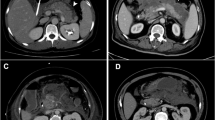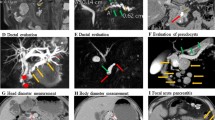Abstract
Purpose: Compare CT and MRI for fluid/debris component estimate and pancreatic duct (PD) communication with organized pancreatic fluid collections in acute pancreatitis. Evaluate fat density globules on CT as marker for debris. Methods: 29 Patients with 46 collections with CECT and MRI performed ≥4 weeks of symptom onset assessed for necrotizing pancreatitis, estimated percentage of fluid volume and PD involvement by two radiologists on separate occasions. T2WI used as standard for estimated percentage of fluid volume. Presence of fat globules and fluid attenuation on CT was recorded. Spearman rank correlation and kappa statistics were used to assess the correlation between imaging techniques and interreader agreement, respectively. Results: Necrotizing pancreatitis seen on CT in 27 (93%, κ 0.119) vs. 20 (69%, κ 0.748) patients on MRI. CT identified 42 WON and 4 pseudocysts vs. 34 WON, and 12 pseudocysts on MRI. Higher interreader agreement for percentage fluid volume on MRI (κ = 0.55) vs. CT (κ = 0.196). Accuracy of CT in evaluation of percentage fluid volume was 65% using T2WI MRI used as standard. Fat globules identified on CT in 13(65%) out of 20 collections containing <75% fluid vs. 4(15%) out of 26 collections containing >75% fluid (p = 0.0001). PD involvement confidently excluded on CT in 68% collections vs. 93% on MRI. Conclusion: MRI demonstrates higher reproducibility for fluid to debris component estimation. Fat globules on CT were frequently seen in organized pancreatic fluid collections with large amount of debris. PD disruption more confidently excluded on MRI. This information may be helpful for pre-procedure planning.







Similar content being viewed by others
References
Banks PA, Bollen TL, Dervenis C, et al. (2013) Classification of acute pancreatitis-2012: revision of the Atlanta classification and definitions by international consensus. Gut 62(1):102–111. doi:10.1136/gutjnl-2012-302779
Zaheer A, Singh VK, Qureshi RO, Fishman EK (2013) The revised Atlanta classification for acute pancreatitis: updates in imaging terminology and guidelines. Abdom Imaging 38(1):125–136. doi:10.1007/s00261-012-9908-0
Freeny PC, Hauptmann E, Althaus SJ, Traverso LW, Sinanan M (1998) Percutaneous CT-guided catheter drainage of infected acute necrotizing pancreatitis: techniques and results. AJR 170(4):969–975
Howard TJ, Rhodes GJ, Selzer DJ, et al. (2001) Roux-en-Y internal drainage is the best surgical option to treat patients with disconnected duct syndrome after severe acute pancreatitis. Surgery 130(4):714–719 ((discussion 719–721)). doi:10.1067/msy.2001.116675
Nealon WH, Walser E (2002) Main pancreatic ductal anatomy can direct choice of modality for treating pancreatic pseudocysts (surgery versus percutaneous drainage). Ann Surg 235(6):751–758
Nealon WH, Walser E (2005) Surgical management of complications associated with percutaneous and/or endoscopic management of pseudocyst of the pancreas. Ann Surg 241(6):948–957 (discussion 957–960)
Papachristou GI, Takahashi N, Chahal P, Sarr MG, Baron TH (2007) Peroral endoscopic drainage/debridement of walled-off pancreatic necrosis. Ann Surg 245(6):943–951. doi:10.1097/01.sla.0000254366.19366.69
Freeman ML, Werner J, van Santvoort HC, et al. (2012) Interventions for necrotizing pancreatitis: summary of a multidisciplinary consensus conference. Pancreas 41(8):1176–1194. doi:10.1097/MPA.0b013e318269c660
Saxena P, Singh VK, Messallam A, et al. (2014) Resolution of walled-off pancreatic necrosis by EUS-guided drainage when using a fully covered through-the-scope self-expandable metal stent in a single procedure (with video). Gastrointest Endosc 80(2):319–324. doi:10.1016/j.gie.2014.04.041
Mainwaring R, Kern J, Schenk WG, III, Rudolf LE (1989) Differentiating pancreatic pseudocyst and pancreatic necrosis using computerized tomography. Ann Surg 209(5):562–567 (discussion 567–568)
Kim YK, Kim CS, Han YM (2009) Role of fat-suppressed t1-weighted magnetic resonance imaging in predicting severity and prognosis of acute pancreatitis: an intraindividual comparison with multidetector computed tomography. J Comput Assist Tomogr 33(5):651–656. doi:10.1097/RCT.0b013e3181979282
Lee MJ, Rattner DW, Legemate DA, et al. (1992) Acute complicated pancreatitis: redefining the role of interventional radiology. Radiology 183(1):171–174. doi:10.1148/radiology.183.1.1549667
Hariri M, Slivka A, Carr-Locke DL, Banks PA (1994) Pseudocyst drainage predisposes to infection when pancreatic necrosis is unrecognized. Am J Gastroenterol 89(10):1781–1784
Belle S, Collet P, Post S, Kaehler G (2010) Temporary cystogastrostomy with self-expanding metallic stents for pancreatic necrosis. Endoscopy 42(6):493–495. doi:10.1055/s-0029-1244021
Gardner TB, Coelho-Prabhu N, Gordon SR, et al. (2011) Direct endoscopic necrosectomy for the treatment of walled-off pancreatic necrosis: results from a multicenter U.S. series. Gastrointest Endosc 73(4):718–726. doi:10.1016/j.gie.2010.10.053
Berzosa M, Maheshwari S, Patel KK, Shaib YH (2012) Single-step endoscopic ultrasonography-guided drainage of peripancreatic fluid collections with a single self-expandable metal stent and standard linear echoendoscope. Endoscopy 44(5):543–547. doi:10.1055/s-0031-1291710
Varadarajulu S, Phadnis MA, Christein JD, Wilcox CM (2011) Multiple transluminal gateway technique for EUS-guided drainage of symptomatic walled-off pancreatic necrosis. Gastrointest Endosc 74(1):74–80. doi:10.1016/j.gie.2011.03.1122
Takahashi N, Papachristou GI, Schmit GD, et al. (2008) CT findings of walled-off pancreatic necrosis (WOPN): differentiation from pseudocyst and prediction of outcome after endoscopic therapy. Eur Radiol 18(11):2522–2529. doi:10.1007/s00330-008-1039-1
Baron TH, Thaggard WG, Morgan DE, Stanley RJ (1996) Endoscopic therapy for organized pancreatic necrosis. Gastroenterology 111(3):755–764
Morgan DE, Baron TH, Smith JK, Robbin ML, Kenney PJ (1997) Pancreatic fluid collections prior to intervention: evaluation with MR imaging compared with CT and US. Radiology 203(3):773–778
Akshintala VS, Saxena P, Zaheer A, et al. (2013) A comparative evaluation of outcomes of endoscopic versus percutaneous drainage for symptomatic pancreatic pseudocysts. Gastrointest Endosc. doi:10.1016/j.gie.2013.10.032
Balthazar EJ, Robinson DL, Megibow AJ, Ranson JH (1990) Acute pancreatitis: value of CT in establishing prognosis. Radiology 174(2):331–336
Mortele KJ, Wiesner W, Intriere L, et al. (2004) A modified CT severity index for evaluating acute pancreatitis: improved correlation with patient outcome. AJR 183(5):1261–1265
Soto JA, Alvarez O, Munera F, et al. (2001) Traumatic disruption of the pancreatic duct: diagnosis with MR pancreatography. AJR 176(1):175–178. doi:10.2214/ajr.176.1.1760175
Rasband WS (1997–2012) ImageJ. U.S. National Institutes of Health, Bethesda, MA
Landis JR, Koch GG (1977) The measurement of observer agreement for categorical data. Biometrics 33(1):159–174
Madry S, Fromm D (1994) Infected retroperitoneal fat necrosis associated with acute pancreatitis. J Am Coll Surg 178(3):277–282
Howard JM, Wagner SM (1989) Pancreatography after recovery from massive pancreatic necrosis. Ann Surg 209(1):31–35
Bakker OJ, van Santvoort H, Besselink MG, et al. (2012) Extrapancreatic necrosis without pancreatic parenchymal necrosis: a separate entity in necrotising pancreatitis? Gut. doi:10.1136/gutjnl-2012-302870
Singh VK, Bollen TL, Wu BU, et al. (2011) An assessment of the severity of interstitial pancreatitis. Clin Gastroenterol Hepatol 9(12):1098–1103. doi:10.1016/j.cgh.2011.08.026
Balthazar EJ (2002) Acute pancreatitis: assessment of severity with clinical and CT evaluation. Radiology 223(3):603–613
Merkle EM, Gorich J (2002) Imaging of acute pancreatitis. Eur Radiol 12(8):1979–1992. doi:10.1007/s00330-001-1235-8
Sandrasegaran K, Tann M, Jennings SG, et al. (2007) Disconnection of the pancreatic duct: an important but overlooked complication of severe acute pancreatitis. Radiographics 27(5):1389–1400. doi:10.1148/rg.275065163
Tann M, Maglinte D, Howard TJ, et al. (2003) Disconnected pancreatic duct syndrome: imaging findings and therapeutic implications in 26 surgically corrected patients. J Comput Assist Tomogr 27(4):577–582
Woods RW, Akshintala VS, Singh VK, et al. (2014) CT severity of post-ERCP pancreatitis: results from a single tertiary medical center. Abdom Imaging. doi:10.1007/s00261-014-0147-4
Drake LM, Anis M, Lawrence C (2012) Accuracy of magnetic resonance cholangiopancreatography in identifying pancreatic duct disruption. J Clin Gastroenterol 46(8):696–699. doi:10.1097/MCG.0b013e31825003b3
Kariniemi J, Sequeiros RB, Ojala R, Tervonen O (2006) Feasibility of MR imaging-guided percutaneous drainage of pancreatic fluid collections. J Vasc Interv Radiol 17(8):1321–1326. doi:10.1097/01.RVI.0000231957.91785.63
Varadarajulu S, Bang JY, Sutton BS, Trevino JM, Christein JD, Wilcox CM (2013) Equal efficacy of endoscopic and surgical cystogastrostomy for pancreatic pseudocyst drainage in a randomized trial. Gastroenterology 145(3):583–590, e581. doi:10.1053/j.gastro.2013.05.046
Lecesne R, Taourel P, Bret PM, Atri M, Reinhold C (1999) Acute pancreatitis: interobserver agreement and correlation of CT and MR cholangiopancreatography with outcome. Radiology 211(3):727–735. doi:10.1148/radiology.211.3.r99jn08727
Author information
Authors and Affiliations
Corresponding author
Rights and permissions
About this article
Cite this article
Kamal, A., Singh, V.K., Akshintala, V.S. et al. CT and MRI assessment of symptomatic organized pancreatic fluid collections and pancreatic duct disruption: an interreader variability study using the revised Atlanta classification 2012. Abdom Imaging 40, 1608–1616 (2015). https://doi.org/10.1007/s00261-014-0303-x
Published:
Issue Date:
DOI: https://doi.org/10.1007/s00261-014-0303-x




